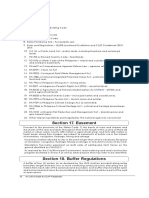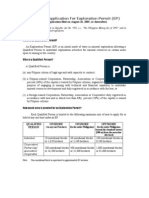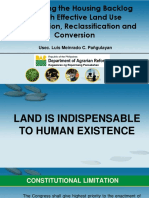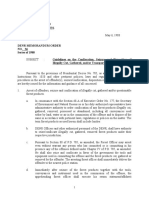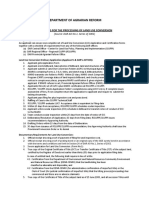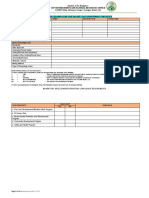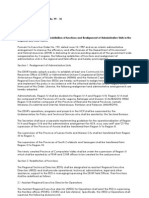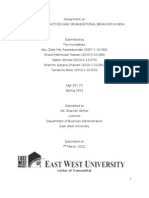Contingent Liability and Rehabilitation Fund
Contingent Liability and Rehabilitation Fund
Uploaded by
Kit ChampCopyright:
Available Formats
Contingent Liability and Rehabilitation Fund
Contingent Liability and Rehabilitation Fund
Uploaded by
Kit ChampOriginal Title
Copyright
Available Formats
Share this document
Did you find this document useful?
Is this content inappropriate?
Copyright:
Available Formats
Contingent Liability and Rehabilitation Fund
Contingent Liability and Rehabilitation Fund
Uploaded by
Kit ChampCopyright:
Available Formats
CONTINGENT LIABILITY AND REHABILITATION FUND
Contingent Liability and Rehabilitation Fund
Cognizant of the need to ensure just and timely compensation for damages
and progressive and sustainable rehabilitation for any adverse effect a mining
operation or activity may cause, the Department through the Bureau shall
institutionalize an environmental guarantee fund mechanism to be known collectively
as the CLRF.
The CLRF shall be in the form of the MRF, the MWT Fees and the Final Mine
Rehabilitation and Decommissioning Fund and shall be administered by the CLRF
Steering Committee as provided for in Section 193 hereof.
Mine Rehabilitation Fund
An MRF shall be established and maintained by each operating
Contractor/Permit Holder as a reasonable environmental deposit to ensure availability
of funds for the satisfactory compliance with the commitments and performance of
the activities stipulated in the EPEP/AEPEP during specific project phase. The MRF
shall be deposited as a Trust F und in a Government depository bank and shall be
used for physical and social rehabilitation of areas and communities affected by
mining activities and for research on the social, technical and preventive aspects of
rehabilitation.
The MRF shall be in two forms, namely:
a. Monitoring Trust Fund (MTF). This Fund shall be initiated by the
Contractor/Permit Holder and shall be deposited in a mutually
acceptable Government depository bank for the exclusive use in
the monitoring program approved by the MRF Committee.
The MTF shall be in cash and in an amount to be
determined by the MRF Committee which shall not be less than
the amount of One Hundred Fifty Thousand Pesos
(PhP150,000.00) to cover maintenance and other operating
budget for the transportation and travel expenses, cost of
laboratory analysis, cost of supplies and materials, cost of
communication services, cost of consultancy work and other
reasonable expenses incurred by the monitoring team: Provided,
That the Secretary shall be authorized to increase the said
amount when national interest and public welfare so require,
upon the recommendation of the Director. The Contractor/Permit
Holder shall notify the Chair or the Co-Chair of the MRF
Committee of its compliance with the deposit requirement
through a certification from the bank.
Authorization for the disbursement from the MTF shall
only be given by the designated Representatives of both the
MRF Committee and the Contractor/Permit Holder.
Replenishment of this amount shall be done quarterly to
correspond to the expenses incurred by the monitoring team.
b. Rehabilitation Cash Fund. The Contractor/ Permit Holder shall
set up a Rehabilitation Cash Fund (RCF) for a designated
amount to ensure compliance with the approved rehabilitation
activities and schedules, including research programs, as
defined in the EPEP/AEPEP. The RCF shall be equivalent to ten
percent (10%) of the total amount needed to implement the
EPEP or Five Million Pesos (PhP5,000,000.00), whichever is
lower. The RCF shall be deposited as a Trust Fund in a mutually
agreed Government depository bank: Provided, That said
amount shall be deposited in four (4) equal quarterly deposits
within fifteen (15) calendar days from the beginning of each
quarter of the first year following the approval of the EPEP.
A request for withdrawal and disbursement from said
amount(s) by the Contractor/Permit Holder shall be based on its
EPEP/AEPEP and shall be submitted to the MRF Committee for
consideration and approval, copy furnished the CLRF Steering
Committee.
In the event of withdrawals from the RCF, the Contractor
shall annually replenish the RCF so as to maintain the minimum
required amount thereof.
Upon written notification by the Contractor/Permit Holder to the Chair of the
MRF Committee that the mine has reached the end of its operating life, the RCF
shall, after payment of all outstanding obligations, be terminated and the remaining
amount therein, including interests, shall be returned to the Contractor/Permit Holder.
In lieu thereof, the Final Mine Rehabilitation and Decommissioning Fund (FMRDF),
as stipulated in Section 187-B of these rules and regulations, shall be utilized to fund
all decommissioning and/or rehabilitation activities contained in the approved Final
Mine Rehabilitation and/or Decommissioning Plan (FMR/DP) for the succeeding
years until the objectives of mine closure have been achieved.
The Mine Rehabilitation Fund Committee
An MRF Committee shall be created in each Region where active mining
operations exist and shall have the following duties and responsibilities:
a. Conducts preliminary evaluation on the submitted EPEP and
consults with credible experts, as may be required, to clarify
proposals and to discuss the adequacy of control and
rehabilitation measures: Provided, That the MRF Committee
shall evaluate and approve/disapprove the submitted EPEP for
Industrial Sand and Gravel Permit and Quarry Permit.
b. Manages, operates, monitors and looks after the safety of the
MRFs and FMRDFs and that shall be established and deposited
in a Government depository bank in accordance with the
provisions of these implementing rules and regulations;
c. Resolves issues involving the progressive mine rehabilitation
programs that shall be implemented;
d. Hires credible experts to do independent studies and researches
on the environmental, engineering and sociocultural impacts of
the projects in order to assist it in making judicious decisions;
e. Ensures that the approved EPEPs/AEPEPs shall be strictly
implemented by the Contractors/Permit Holders;
f. Deputizes an MMT to serve as its monitoring arm with the
Regional Office concerned taking the lead role;
officer of the meeting shall not vote in any matter brought before the Committee
except in case of a tie.
The Committee shall provide the CLRF Steering Committee with a copy of the
minutes of its meetings within seven (7) working days after.
The Multipartite Monitoring Team (MMT)
An MMT shall be deputized by the MRF Committee, as provided for in Section
182 hereof, to serve as the monitoring arm of said Committee and shall be composed
of the following:
a. Representative from Regional Office as Head;
b. Representative from Department Regional Office as Member;
c. Representative from the EMB Regional Office as Member;
d. Representative of the Contractor/Permit Holder as Member.
e. Representative from the affected community(ies) as Member;
f. Representative from the affected ICCs, if any, as Member; and
g. Representative from an environmental NGO.
The MMT may request the MRF Committee for technical assistance when
deemed necessary. The Head of the MMT shall submit to the MRF Committee, at
least five (5) working days before the scheduled regular meetings of the latter, a
report on the status and/or result of its monitoring activities as provided for in Section
174 hereof, copy furnished the CLRF Steering Committee.
Disbursements from the MRF
Withdrawal from the MRF shall be made by the Contractor/Permit Holder only
with the written instruction to the bank issued by the MRF Committee authorizing the
Contractor/Permit Holder to withdraw the amount from the MRF. The amount to be
withdrawn shall be in accordance with the AEPEP and shall be approved by the MRF
Committee, copy furnished the CLRF Steering Committee.
Any one of the following shall be authorized to issue the instruction to the bank
on behalf of the MRF Committee:
a. The Chair,
b. The Co-Chair or
c. The designated representative of either (a) or (b).
In the event that none of the above-mentioned persons issues the instruction
to the bank after the lapse of thirty (30) calendar days from the time the written
request for instruction is received by them, the Contractor/Permit Holder shall have
the authority to sign the instruction on behalf of the MRF Committee and to withdraw
the amount in accordance with the approved AEPEP.
Final Mine Rehabilitation/ Decommissioning Plan
The FMR/DP or Mine Closure Plan shall be integrated in the EPEP submitted
by Contractors/Permit Holders to the MRF Committee through the Regional Office
and to the CLRF Steering Committee through the Bureau. Using risk-based
methodologies/approaches, the FMR/DP shall consider all mine closure scenarios
and shall contain cost estimates for the implementation of the FMR/DP, taking in
consideration expected inflation, technological advances, the unique circumstances
faced by the mining operation, among others: Provided, That such estimates shall be
based on the cost of having the decommissioning and/or rehabilitation works done by
third party contractors: Provided, further, That the estimates, on a per year basis,
shall cover the full extent of work necessary to achieve the objectives of mine closure
such as, but shall not be limited to, decommissioning, rehabilitation, maintenance and
monitoring and employee and other social costs, including residual care, if necessary,
over a ten-year period. The FMR/DP shall be subject to pre-evaluation by the MRF
Committee and to final approval by the CLRF Steering Committee.
Detailed guidelines regarding the implementation of this Section shall be
formulated by the Secretary through the Director.
FMR/DP in relation to ECC
The submission and approval of a FMR/DP, in lieu of the Abandonment/
Decommissioning Plan under Section 9.4 of Department Administrative Order No.
2003-30, shall be incorporated as a mandatory requirement in the ECC being issued
by the DENR Secretary, EMB Director, or EMB Regional Director to
Contractors/Permit Holders.
The Final Mine Rehabilitation and Decommissioning Fund
In accordance with Section 71 of RA No. 7942 and Item f, Section 1 of
Executive Order No. 270-A, a Final Mine Rehabilitation and Decommissioning Fund
(FMRDF) shall be established by each operating Contractor/Permit Holder to ensure
that the full cost of the approved FMR/DP is accrued before the end of the operating
life of the mine. The FMRDF shall be deposited as a trust fund in a Government
depository bank and shall be used solely for the implementation of the approved
FMR/DP.
Annual cash provisions shall be made by Contractors/Permit Holders to a
FMRDF based on the formula:
Annual Provision = Cost of Implementing the Approved FMR/DP x Percentage
Required Per Table 1
Based on the expected mine life, the initial annual cash provision shall be
made to the MRF Committee within sixty (60) days from the date of the FMR/DP’s
approval and every anniversary date thereafter: Provided, That, on application by the
Contractor/Permit Holder, the MRF Committee may allow a later date for the payment
of the first annual provision.
Disbursements from the FMRDF
Withdrawal from the FMRDF shall be approved by the CLRF Committee upon
recommendation by the MRFC based on the approved work and financial plan:
Provided, That amounts incurred by the Contractor/Permit Holder for progressive
rehabilitation/annual environmental and enhancement programs pursuant to its
EPEP/AEPEP cannot be reimbursed or credited to the FMRDF and shall continue to
be governed by relevant provisions of these implementing rules and regulations.
Progress Reporting
The Contractor/Permit Holder shall submit a progress report, if applicable,
containing details of fully, partially, and on-going rehabilitation activities relative to the
implementation of the FMR/DP.
The report shall be submitted to the MRF Committee for review and evaluation
within thirty (30) days from the end of the term of the preceding work and financial
plan, if applicable. The results of the Committee’s review and evaluation shall be
integrated in the succeeding year’s work and financial plan.
Review of the FMR/DP
The FMR/DP shall be reviewed and/or revised at a date not exceeding two (2)
years after its approval and every two (2) years thereafter. The FMR/DP may also be
reviewed and/or revised whenever amendments are justified by changes in mining
activities; the review and/or revision may be made on the Contractor’s/Permit
Holder’s initiative or at the request of the Director/Regional Director concerned.
In conjunction with the review and/or revision of the FMR/DP, annual
provisions to the FMRDF may be increased or decreased based on such factors as:
To credit progressive rehabilitation works undertaken by the Contractor/Permit
Holder; and
To account for changes in the nature or cost of work to be done pursuant to
the approved FMR/DP.
Final Relinquishment of Rehabilitated Areas
The Contractor/Permit Holder shall prepare and submit a Final Rehabilitation
Report with third party Environmental Audit (FRR with EA) for preevaluation by the
MRF Committee and final approval by the CLRF Steering Committee, if, based on the
assessment of the Contractor/Permit Holder, that the objectives of mine closure, as
contained in the approved FMR/DP, have been achieved.
The MRF Committee and/or CLRF Steering Committee may, after due review
and evaluation of the FRR with EA, conduct field validation of the reported
accomplishments, recommend revision/s to the submitted report, and/or require
additional rehabilitation works to be undertaken: Provided, That if residual care is still
needed, the Contractor/Permit Holder shall submit a Site Management Plan detailing
how the identified residual rehabilitation commitments are to be managed: Provided,
further, That the CLRF Steering Committee shall issue a Certificate of Final
Relinquishment to the Contractor/Permit Holder signifying approval of the FRR with
EA and freeing the Contractor/Permit Holder from any further obligations insofar as
the rehabilitated area/s are concerned.
Any remaining amount, based on the Contractor’s/Permit Holder’s total
FMRDF annual provisions as well as MWTF payments, shall be released back to the
Contractor/Permit Holder: Provided, That any shortfall in the amount needed to
achieve the objectives of mine closure pursuant to the approved FMR/DP and to
implement the Site Management Plan, shall be shouldered by the Contractor/Permit
Holder.
Penalties
Failure of the Contractor/Permit Holder to establish an MRF and an FMRDF
shall be sufficient ground to suspend or cancel the mining operations in the areas
under contracts.
Mine Waste and Tailings Fees Reserve Fund
Mine Waste and Tailings (MWT) fees shall be collected semiannually from
each operating Contractor/Lessee/Permit Holder based on the amounts of mine
waste and mill tailings it generated for the said period. The amount of fees collected
shall accrue to a MWT Reserve Fund and shall be deposited in a Government
depository bank to be used for payment of compensation for damages caused by any
mining operations. The MWT Reserve Fund shall also be utilized for research
projects duly approved by the CLRF Steering Committee which are deemed
necessary for the promotion and furtherance of its objectives.
Section 190. Mine Waste and Tailings Fees
The basic fees that shall accrue to the MWT Reserve Fund shall be
PhP0.05/MT of mine waste produced and PhP0.10/MT of mill tailings generated from
the mining operations except where such mine waste and mill tailings were utilized in
the following manner:
a. Filling materials for underground mine openings;
b. Filling materials for surface mine openings: Provided, That such
materials shall not affect natural drainage systems as may be
determined by the Committee or its duly authorized
representative;
c. Filling materials for engineered tailings dams, roads and housing
areas: Provided, That such areas shall not affect natural
drainage systems as may be so determined by the Committee or
his/her duly authorized representative: Provided, further, That
those with tailings impoundment/disposal system that were found
to have discharged and/or to be discharging solid fractions of
tailings into areas other than the approved tailings disposal area
shall pay PhP50.00/MT without prejudice to other penalties and
liabilities the Contractor/Lessee/Permit Holder shall be subject to
under other existing laws, rules and regulations: Provided, finally,
That said amount shall accrue to the MWT Reserve Fund;
d. Concreting and manufacture of concrete products; and
e. Mine waste impounded for future use: Provided, That a two-year
work program on the utilization of the said materials shall be
submitted together with the semiannual report: Provided, further,
That said materials shall be utilized for its beneficial use within a
period of two (2) years. Mine waste materials, which are not
utilized within the two-year period, shall be charged the
corresponding fee of PhP0.05/MT. Non-submission of the work
program shall mean disqualification from exemption from
payment of fees.
Mining companies utilizing engineered and well-maintained mine waste and
tailings disposal systems with zero-discharge of materials/effluent and/or with
wastewater treatment plants which consistently meet Department standards shall
also be exempted from payment of MWT fees.
The Secretary, upon the recommendation of the Director, is authorized to
increase the said fees when national interest and public welfare so require.
Payment of Mine Waste and Tailings Fees Due
MWT fees shall be payable to the Bureau within forty-five (45) calendar days
after the end of each semester. They shall be based on the sworn semi-annual report
(MGB Form No. 18-1) that shall be submitted to the Bureau, copy furnished the
Regional Office concerned, by each operating Contractor/Lessee/Permit Holder
stating, among others, the following:
a. The amounts of mine waste and/or mill tailings produced,
contained/stored/impounded and/or utilized; and
b. The manner by which the mine waste and/or mill tailings
produced was utilized.
Contractors/Lessees/Permit Holders with no mine waste nor mill tailings
generated shall likewise submit sworn semi-annual reports stating that for the said
period no such materials were generated from their operations.
Penalties
Non-submission of semi-annual reports shall mean non-availment of the
exemption from payment of MWT fees and a penalty of PhP5,000.00.
Failure to comply with payments of the MWT fees provided under Sections
190 and 191 hereof shall mean a ten percent (10%) surcharge on the principal
amount for every month of delay.
The Contractor/Lessee/Permit Holder shall be duty bound to pay for damages
incurred due to previously exempted mine waste and tailings as described in Section
190 hereof.
Payments for the mine waste and tailings generated, which were previously
requested for exemption from payment of fees but were denied based on the
verification report, shall be remitted to the Bureau within sixty (60) calendar days
upon receipt of notice. Failure to comply with the said provision shall mean a ten
percent (10%) surcharge on the principal amount for every month of delay.
The Contingent Liability and Rehabilitation Fund Steering
Committee
An Interagency CLRF Steering Committee shall be created and shall have the
following duties and responsibilities:
a. Evaluates and approves/disapproves the submitted EPEP,
FMR/DP, and consults with credible experts and advisory
body(ies), as may be required, to clarify proposals and to discuss
the adequacy of control and rehabilitation measures;
b. Monitors the MRFs that shall be established and deposited in a
Government depository bank in accordance with the provisions
of these implementing rules and regulations;
c. Monitor the FMRDFs that shall be established pursuant to these
rules and regulations;
d. Resolves issues involving the final mine rehabilitation and
decommissioning that shall be implemented;
e. Hires credible experts to do independent studies and researches
on the environmental, engineering and sociocultural impacts of
the projects in order to assist it in making judicious decisions;
f. Monitors and evaluates the performance of the MRF
Committees;
g. Administers the Mine Waste and Tailings Fees Reserve Fund;
h. Evaluates and decides on all applications for compensation for
damages and awards compensations therefore;
i. Prescribes documentary requirements for applications for
compensation for damages;
j. Appoints and/or designates members of the Technical Working
Group to serve as the technical staff of the Committee and
Regional Investigation and Assessment Teams (RIATs), as
provided for in Sections 196 and 198 hereof, to assist the
Committee in the investigation and assessment of the claims for
compensation for damages: Provided, That the Committee shall
exercise general supervision over them;
k. Provides appropriate funds from the MRFs and MWT Reserve
Fund for the development and implementation of research and
other special projects, which are deemed necessary in promoting
the environmental objectives of these implementing rules and
regulations;
l. Implements duly approved guidelines, rules and regulations;
m. Formulates policy recommendations to strengthen the
environmental provisions of these implementing rules and
regulations for consideration of the Secretary;
n. Recommends to the Secretary the granting of allowances to
officials and personnel performing functions and duties relative to
the effective implementation of these implementing rules and
regulations;
o. Prepares and submits to the Secretary, within thirty (30) calendar
days after the end of each year, an annual report of
accomplishments and such periodic reports of activities, as may
be required; and
p. Performs other functions as may be assigned by the Secretary.
Section 194. Composition of the CLRF Steering Committee
The CLRF Steering Committee shall be composed of the following officials or
their duly authorized representatives:
a. Director as Chair;
b. Director of EMB as Vice-Chair;
c. Director of Lands Management Bureau as Member;
d. Director of Forest Management Bureau as Member;
e. Director of Bureau of Soils and Water Management as Member;
f. Director of Bureau of Plant Industry as Member;
g. Director of Bureau of Fisheries and Aquatic Resources as
Member;
h. Administrator of the National Irrigation Administration as
Member; and
i. Assistant Director of the Bureau as Committee Coordinator.
In case the Chair and/or the Vice-Chair can not personally attend a meeting or
function of the CLRF Steering Committee, he/she shall designate or appoint a
representative, who shall be duly authorized in writing to have full power and
authority to act in his/her behalf.
The Bureau shall provide the secretariat and administrative supports, as may
be deemed necessary, to the CLRF Steering Committee.
Meetings of the CLRF Steering Committee
The Committee shall hold quarterly meetings: Provided, That any member of
the Committee may call a special meeting as he/she may deem necessary: Provided,
further, That notices of the meetings stating the date, time, place and agenda
therefore shall be sent by the Committee Chair or Vice-Chair to all members at least
ten (10) working days before the intended date of the meetings.
In all meetings, the presence of at least five (5) members shall constitute a
quorum to conduct business. The meetings shall be presided by the Chair or, in
his/her absence, by the Vice-Chair. In the absence of the Chair and the Vice-Chair,
the meetings shall be presided by either of their representatives. Unless otherwise
provided herein, a majority vote of the members present in the meeting shall be
required to give effect to any resolutions or decisions of the Committee. The presiding
officer of the meeting shall not vote in any matter brought before the Committee
except in case of a tie.
The Technical Working Group
To assist the CLRF Steering Committee, a Technical Working Group (TWG)
shall be created in the Bureau and shall have the following functions:
a. Acts as technical staff to the CLRF Steering Committee;
b. Receives, processes and evaluates the submitted EPEP and
FMR/DP as to its form and substance, imposes additional
requirements and documentation deemed\ necessary and
consults with credible experts, including the Director of the
Philippine Social Science Council, Director of the National
Museum, Offices of the Northern and Southern Cultural
Communities, as well as other advisory body(ies) that may be
required to clarify proposals and to discuss the adequacy of
control and rehabilitation measures;
c. Conducts annual environmental audit to ensure that the
approved EPEPs/AEPEPs and FMR/DPs shall be strictly
implemented by the Contractors/Permit Holders;
d. Conducts continuing studies and research on policy options,
strategies and approaches to effective implementation of
environmental protection and enhancement programs and
recommends such measures as may be required to address
therefore to the Committee;
e. Verifies the amounts of mine waste and mill tailings generated by
Contractors/Lessees/ Permit Holders;
f. Computes and collects the MWT fees to be paid by Contractors/
Lessees/Permit Holders;
g. Receives, processes, evaluates and conducts preliminary
investigations, if necessary, of claims for damages and submits
appropriate recommendations to the CLRF Committee;
h. Assists in the investigation and assessment of claims for
damages and submits appropriate recommendations to the
CLRF Steering Committee;
i. Develops, packages and recommends research and other
special projects concerning mining and the environment;
j. Determines/estimates/prepares the cost of rehabilitating
damaged industrial, commercial, residential, agricultural and
forest lands, marine and aquatic resources and placer and lode
small-scale mining areas caused primarily by mining operations;
k. Coordinates and monitors the activities of the RIATs as provided
for in Section 193 hereof;
l. Drafts guidelines, rules, regulations, resolutions and other
documents in connection with the environmental provisions of
these implementing rules and regulations; and
m. Performs other functions as may be assigned by the CLRF
Steering Committee.
Contingent Liability and Rehabilitation Steering Committee
Administrative Fund
The Director shall ensure that adequate budget shall be allocated every year
from its regular appropriation for the CLRF Steering Committee and shall include
sufficient maintenance and operating budgets for actual field and travel expenses
needed during mine site inspections, cost of in-house and external training, monthly
honoraria for members of said Committee, cost of supplies and materials, cost of
communication services and adequate capital outlay for the purchase of required
photocopying machines, computers, microfiche machines and other support
equipment.
The Director shall likewise allocate adequate financial support from the MRFs
and for the cost of consultancy and other expenses that are deemed necessary in
carrying out the functions of the Committee related to EPEP and FMR/DP evaluation
and monitoring.
Section 198. The Regional Investigation and Assessment Teams
To assist the CLRF Steering Committee in the investigation and assessment
of the claims for compensation for damages, there shall be a RIAT, which shall be
composed of representatives from the Regional Offices and other member agencies
whose services are deemed needed. The RIAT shall be headed by the Regional
Director and shall have the following functions:
a. Provides advice to interested parties on matters related to claims for
compensation for damages under these implementing rules and
regulations;
b. Provides applications and other related forms to prospective claimants
for damages;
c. Receives applications for compensation for damages under these
implementing rules and regulations;
d. Conducts field investigations and assessments of claims for damages
(MGB Form No.18-3) and submits reports to the CLRF Steering
Committee through the TWG;
e. Creates, whenever and wherever deemed necessary, Local Task
Forces to assist the RIATs in carrying out its functions; and
f. Performs other functions that may be assigned by the Director.
Section 199. Application for Compensation for Damages
Compensable damages are those damages caused by any mining operations
on lives and personal safety; lands, agricultural crops and forest products, marine life
and aquatic resources, cultural and human resources; and infrastructure and the
revegetation and rehabilitation of silted farm lands and other areas devoted to
agriculture and fishing.
The following are qualified to apply for compensation for damages:
a. Any individual, in the event of loss or damage to his/her life,
personal safety or property;
b. Any private owners of damaged infrastructures, forest products,
marine, aquatic and inland resources;
c. Any applicant or successor-in-interest for damage to private
lands who holds title or any evidence of ownership;
d. Any applicant or successor-in-interest for damage to alienable
and disposable lands;
e. Any agricultural lessors, lessees and share tenants for damage
to crops; and
f. Any ICC in case of damage to burial grounds and cultural
resources.
Provided, That any damage caused to the property of a surface owner,
occupant or concessionaire, as provided for in Chapter X on Surface Rights, shall be
governed by the pertinent provisions of said chapter.
Application for compensation for damages under these implementing rules
and regulations shall be filed in a prescribed application forms (MGB Form No. 18-2)
with the RIAT within thirty (30) calendar days from the occurrence of the damage.
Applications should be supported by the following documents:
a. Proof of ownership, such as tax declaration, perfected land titles,
homestead and free patent. It should be understood, however,
that tax declarations shall be honored as proof of ownership only
for the purposes of compensation under these implementing
rules and regulations;
b. Receipt of expenditures for improvements made in the affected
property(ies); and
c. Other requirements that may be required by the CLRF
Committee.
Section 200. Evaluation of and Compensation for Claims for Damages
The following guidelines shall apply in the evaluation of claims for damages
under these implementing rules and regulations:
a. Amounts paid as compensation for claims for damages shall be
drawn from the MWT fees collected from Contractor(s)/
Lessee(s)/Permit Holder(s), as may be determined by the CLRF
Steering Committee: Provided, That in case the assessed
amount of damage exceeds the MWT fees paid for, the
Contractor(s)/Lessee(s)/ Permit Holder(s) concerned shall be
duty bound to pay for the remaining balance;
b. Damages to lives and personal safety shall be compensated at
an amount as provided for in other pertinent laws;
c. Damages caused to agricultural lands, which render such lands
useless for the traditional purpose for which they were intended
for, may be compensated at an amount equivalent to either one
of the following, whichever is lower:
1. The fair market value of the lands as per tax declaration;
or
2. The cost of rehabilitation of the land;
d. Damages to agricultural lands resulting in partial loss of
productivity may be compensated at an amount equivalent to the
costs of rehabilitation;
e. Damages to industrial and residential lands may be
compensated at an amount equivalent to the costs of
rehabilitation;
f. Damages resulting in total or partial loss of agricultural crops,
forest products and/or inland aquatic resources may be
compensated at an amount equivalent to the loss of projected
net income therefrom;
g. Damages to infrastructures may be compensated at an amount
equivalent to the costs of rehabilitation to be determined by the
CLRF Steering Committee;
h. The amount of compensation for damages shall be based on the
amount claimed or the amount assessed, whichever is lower;
i. n case of private leased lands, compensation under these
implementing rules and regulations shall be paid in accordance
with the sharing agreement between the private landowner(s)
and the lessee(s). In the absence of such an agreement,
seventy-five percent (75%) of the compensation shall be paid to
the lessee and twenty five percent (25%) shall be paid to the
landowner;
j. Damages compensated by the operating mining company(ies)
shall no longer be considered compensable under these
implementing rules and regulations: Provided, That written
approval has been secured from the CLRF Steering Committee.
Such payment shall be credited to the Contractor/Lessee/Permit
Holder concerned for the next paying period. A waiver signed as
a condition for payment of such compensation by the
Contractor/Lessee/Permit Holder shall also be considered as a
waiver under these implementing rules and regulations;
k. Any damage to burial grounds and cultural resources of an ICC
shall be compensated in an amount to be determined by said
Community, the LGU concerned and/or the National Museum;
and
l. The decision of the CLRF Committee shall be final and executory
unless appealed to the Secretary within thirty (30) calendar days
from receipt of the decision.
You might also like
- Checklist of Requirements Application For Renewal of Mineral Production Sharing AgreementDocument2 pagesChecklist of Requirements Application For Renewal of Mineral Production Sharing AgreementChristian Magbag100% (3)
- Guide For The Conduct of Monitoring of QuarryDocument5 pagesGuide For The Conduct of Monitoring of QuarryMa. SheilaNo ratings yet
- Resetlement Action Plan SampleDocument205 pagesResetlement Action Plan SampleClifford Trinidad100% (1)
- 3.zara Home Product Assorment.Document6 pages3.zara Home Product Assorment.Eugenio Pavon Gutierrez100% (2)
- Leadership Style v1Document5 pagesLeadership Style v1Ousman BahNo ratings yet
- SOL Diploma NursingDocument22 pagesSOL Diploma NursingNonso NwakaNo ratings yet
- Republic o F The Philippines Department o F Environment and Natural ResourcesDocument16 pagesRepublic o F The Philippines Department o F Environment and Natural ResourcesKrist Jan Jimenez SeparaNo ratings yet
- CADCsDocument38 pagesCADCsKatrina OngocoNo ratings yet
- MPSADocument13 pagesMPSACris Sosa100% (1)
- DPWH Department Order No. 5 Series 2003Document6 pagesDPWH Department Order No. 5 Series 2003Jeff D. AgustinNo ratings yet
- LUC ChecklistDocument4 pagesLUC ChecklistGerrick TagamolilaNo ratings yet
- Do - 253 - s2003 Asphalt and Concrete Batching PlantsDocument12 pagesDo - 253 - s2003 Asphalt and Concrete Batching PlantsrubydelacruzNo ratings yet
- SAP In-House CashDocument28 pagesSAP In-House CashVenkat Emani100% (2)
- DMO 2004-09 Simplification of Procedures For Mining Contracts and PermitsDocument3 pagesDMO 2004-09 Simplification of Procedures For Mining Contracts and Permitsmark6villegasNo ratings yet
- Min - DMC 97 05Document4 pagesMin - DMC 97 05Jose Salve CabilingNo ratings yet
- RMC No. 28-2023 Annex B (R.A. No. 11898 IRR) PDFDocument44 pagesRMC No. 28-2023 Annex B (R.A. No. 11898 IRR) PDFHershey Gabi100% (1)
- MC 2008-05 - Simplifying The Requirements For LLDA Clearance ApplicationsDocument2 pagesMC 2008-05 - Simplifying The Requirements For LLDA Clearance ApplicationsPacific SpectrumNo ratings yet
- Dredging AllinDocument7 pagesDredging AllinEdrian Paulo De La PenaNo ratings yet
- HLURB CLUP Guidebook Vol 3 11042015Document2 pagesHLURB CLUP Guidebook Vol 3 11042015Sophia de Vera100% (1)
- Application For Ore Transport Permit: Mines and Geosciences BureauDocument1 pageApplication For Ore Transport Permit: Mines and Geosciences Bureauirenev_1No ratings yet
- 20201711-MC20 - 010-MGB RSGA VerificationDocument1 page20201711-MC20 - 010-MGB RSGA Verificationmgbembedded.xiNo ratings yet
- LLDA Citizens - CharterDocument346 pagesLLDA Citizens - CharterAdoniz TabucalNo ratings yet
- Primer Exploration Permit Philippines 2007Document5 pagesPrimer Exploration Permit Philippines 2007leov4777No ratings yet
- Republic of The Philippines Civil Service CommissionDocument6 pagesRepublic of The Philippines Civil Service CommissionCamNo ratings yet
- 2015-06-30 NWRB Water Rights Permit Application Form (With Instructions)Document4 pages2015-06-30 NWRB Water Rights Permit Application Form (With Instructions)Grace Renon100% (1)
- Denr Administrative Order No. 2005 - 08 Subject: Providing For New Fees and Charges For Various Services of The Mines and Geosciences BureauDocument24 pagesDenr Administrative Order No. 2005 - 08 Subject: Providing For New Fees and Charges For Various Services of The Mines and Geosciences BureauShenalie Apostol TalozaNo ratings yet
- DAO 2010 21 Consolidated DAODocument144 pagesDAO 2010 21 Consolidated DAOcecilemarisgozalo98100% (2)
- Exploration Permit: Mines and Geosciences BureauDocument4 pagesExploration Permit: Mines and Geosciences BureauJerome AmbaganNo ratings yet
- Dao 2008-20Document4 pagesDao 2008-20Shenno Lester CoseNo ratings yet
- LPTRP FlowchartDocument1 pageLPTRP FlowchartYisrael Ashkenazim0% (1)
- Conversion & Moratorium-AttyPangulayanDocument41 pagesConversion & Moratorium-AttyPangulayanpopoy cayoneNo ratings yet
- C Certificate of Non-AvailmentDocument1 pageC Certificate of Non-AvailmentRon Cedric GarciaNo ratings yet
- Corporatization PPPDocument9 pagesCorporatization PPPCharlotte Francis Marie AmbasNo ratings yet
- Checklist of Requirements Application For Mineral Processing Permit A. Mandatory Requirements Compliances YES NODocument3 pagesChecklist of Requirements Application For Mineral Processing Permit A. Mandatory Requirements Compliances YES NOJANICE MANGINSAYNo ratings yet
- Joint Dar-Denr-lra-ncip Administrative Order No. 01-12Document14 pagesJoint Dar-Denr-lra-ncip Administrative Order No. 01-12brodchatoNo ratings yet
- SHES MANUAL - May 2021 VersionDocument280 pagesSHES MANUAL - May 2021 VersionDemi Lou BaltarNo ratings yet
- Composition of MMT & Other Matters DAO-2017-15Document18 pagesComposition of MMT & Other Matters DAO-2017-15Nathan A. Campo II100% (1)
- Revised GUIDELINES On Appraisal of Government Properties Except Real Estate, Antique Property and Works of ArtDocument40 pagesRevised GUIDELINES On Appraisal of Government Properties Except Real Estate, Antique Property and Works of ArtLanie BalinNo ratings yet
- Dao 2013 01Document7 pagesDao 2013 01gabinuangNo ratings yet
- 2013 NEDA JV Guidelines PDFDocument44 pages2013 NEDA JV Guidelines PDFCharlie dela RosaNo ratings yet
- MGBMC2012 02Document7 pagesMGBMC2012 02Mark Juan Abelon100% (2)
- 1988 DMO 36 - May 6 1988Document16 pages1988 DMO 36 - May 6 1988Melissa AprentadoNo ratings yet
- DAR GuidelinesfortheProcessingofLandUseConversionDocument6 pagesDAR GuidelinesfortheProcessingofLandUseConversionMaricar Badiola CuervoNo ratings yet
- Sand & Gravel Monitoring & Evaluation SheetDocument77 pagesSand & Gravel Monitoring & Evaluation SheetDennis DagoocNo ratings yet
- Monitoring Checklist EditedDocument14 pagesMonitoring Checklist EditedMa. SheilaNo ratings yet
- Commission On Audit Circular NoDocument6 pagesCommission On Audit Circular NoDondi AbacaNo ratings yet
- Calumpang - Sworn Statement of Accountability and Monitoring ClauseDocument1 pageCalumpang - Sworn Statement of Accountability and Monitoring ClauseStewart Paul Torre100% (1)
- 4PH WorkshopDocument7 pages4PH WorkshopBenj OrtizNo ratings yet
- Affidavit of No ComplaintDocument2 pagesAffidavit of No ComplaintJunar PlagaNo ratings yet
- Joint Memorandum Circular (JMC) No. 2021Document49 pagesJoint Memorandum Circular (JMC) No. 2021Nicey RubioNo ratings yet
- Dole BWC InspectionsDocument42 pagesDole BWC InspectionsMario Norman B. CelerianNo ratings yet
- Pulupandan Wind ProjectDocument1 pagePulupandan Wind ProjectNegros Solar PH100% (1)
- 4 ECC Online Requirements GENERICDocument2 pages4 ECC Online Requirements GENERICJhn Cbllr BqngNo ratings yet
- Forest Landuse Agreement For Tourism PurposesDocument4 pagesForest Landuse Agreement For Tourism PurposesMariel Grace DelinNo ratings yet
- 02 ROADMAP On GSC Land CaseDocument23 pages02 ROADMAP On GSC Land CaseMark Christopher Guardaquivil OlegarioNo ratings yet
- FMB Technical Bulletin Number 5 PDFDocument4 pagesFMB Technical Bulletin Number 5 PDFcesar guarinoNo ratings yet
- DENR River Restoration Thru Dredging ActivitiesDocument48 pagesDENR River Restoration Thru Dredging Activitiesmaricor100% (1)
- DENR Administrative Order No 99-14Document3 pagesDENR Administrative Order No 99-14Vivian Escoto de BelenNo ratings yet
- Land Tenure Study FINALDocument106 pagesLand Tenure Study FINALShiela ToremuchaNo ratings yet
- LLDA Clearance Requirement ChecklistDocument1 pageLLDA Clearance Requirement ChecklistJamina CaliganNo ratings yet
- List of Requirements - DENR & LLDA Certificates/permitsDocument3 pagesList of Requirements - DENR & LLDA Certificates/permitsatguintu50% (2)
- Mine Closure/integrated Mine Closure Planning Where The Environmental, Social andDocument15 pagesMine Closure/integrated Mine Closure Planning Where The Environmental, Social andROLAND JOIE GELINo ratings yet
- Ra 7942 (CLRF)Document13 pagesRa 7942 (CLRF)Kit ChampNo ratings yet
- Dao 2001-09Document6 pagesDao 2001-09Veronica GarciaNo ratings yet
- DAO 34 S. 1992Document7 pagesDAO 34 S. 1992Kit ChampNo ratings yet
- Affidavit of Informed Consent, Waiver and Undertaking of Compliance To The Minimum Qualification Standards and RequirementsDocument1 pageAffidavit of Informed Consent, Waiver and Undertaking of Compliance To The Minimum Qualification Standards and RequirementsKit ChampNo ratings yet
- TasksDocument3 pagesTasksKit ChampNo ratings yet
- January 2021: Monday Tuesday Wednesday Thursday Friday Saturday SundayDocument12 pagesJanuary 2021: Monday Tuesday Wednesday Thursday Friday Saturday SundayKit ChampNo ratings yet
- Food Storage ReminderDocument15 pagesFood Storage ReminderKit ChampNo ratings yet
- Home Maintenance ChecklistDocument1 pageHome Maintenance ChecklistKit ChampNo ratings yet
- Personal Budget TrackerDocument46 pagesPersonal Budget TrackerKit ChampNo ratings yet
- Roman GodsDocument16 pagesRoman GodsKit ChampNo ratings yet
- Ra 7942 (MPP)Document4 pagesRa 7942 (MPP)Kit ChampNo ratings yet
- RA 7942 (Transport & Confiscation)Document6 pagesRA 7942 (Transport & Confiscation)Kit ChampNo ratings yet
- RA 7942 (Auxiliary Mining Rights)Document1 pageRA 7942 (Auxiliary Mining Rights)Kit ChampNo ratings yet
- RA 7942 (Transport & Confiscation)Document6 pagesRA 7942 (Transport & Confiscation)Kit ChampNo ratings yet
- Get Professional Nursing Concepts and Challenges Black 6th Edition Test Bank Free All ChaptersDocument33 pagesGet Professional Nursing Concepts and Challenges Black 6th Edition Test Bank Free All Chapterschaervlkova100% (5)
- English ExamDocument2 pagesEnglish ExamRed KatokNo ratings yet
- Bhagavad GitaDocument14 pagesBhagavad GitaAbhilash SreekumarNo ratings yet
- Revision LogisticDocument11 pagesRevision LogisticavacosmicNo ratings yet
- Lectors & Commentators Ministry (LCM) : San Agustin Parish June 1-30, 2021Document3 pagesLectors & Commentators Ministry (LCM) : San Agustin Parish June 1-30, 2021Vin TabiraoNo ratings yet
- QP - WS - CB - IX - Eng - Prose - A Truly Beautiful MindDocument3 pagesQP - WS - CB - IX - Eng - Prose - A Truly Beautiful MindcharthankargargiNo ratings yet
- M.A. Applied PsychologyDocument56 pagesM.A. Applied PsychologyHappyMinds7No ratings yet
- Capella Floor Plan BrochureDocument28 pagesCapella Floor Plan BrochureRahulNo ratings yet
- Abou Ben AdhemDocument2 pagesAbou Ben Adhemgunika tanejaNo ratings yet
- UNIT-2 Indian Banking SystemDocument7 pagesUNIT-2 Indian Banking SystemashokNo ratings yet
- Ancha, Rodelyn E. STARTS WEEK13 Final Period Task 1Document3 pagesAncha, Rodelyn E. STARTS WEEK13 Final Period Task 1Rodd AnchaNo ratings yet
- Global Interstate SystemDocument17 pagesGlobal Interstate SystemPearl TanNo ratings yet
- Regulations and Conditions of Employment: Company NameDocument4 pagesRegulations and Conditions of Employment: Company NameIzhay MendozaNo ratings yet
- Ece .Document28 pagesEce .Vinayak PonarkarNo ratings yet
- GINZBURG, Carlo. Wooden Eyes - Nine Reflections On DistanceDocument298 pagesGINZBURG, Carlo. Wooden Eyes - Nine Reflections On Distanceojazosdemadera100% (3)
- Invoice - Source One Dec'22Document2 pagesInvoice - Source One Dec'22Sydney DorairajNo ratings yet
- Presidential Decree No. 1987 An Act Creating The Videogram Regulatory BoardDocument5 pagesPresidential Decree No. 1987 An Act Creating The Videogram Regulatory BoardAljon RiñosNo ratings yet
- 1.2.1.8 Lab - Selecting Switching Hardware - ILM PDFDocument5 pages1.2.1.8 Lab - Selecting Switching Hardware - ILM PDFMaksim Korsakov83% (6)
- List of Articles - AstrogeographyDocument38 pagesList of Articles - AstrogeographyJohn ComptonNo ratings yet
- Reflection Paper 04 - OlaerDocument11 pagesReflection Paper 04 - OlaerDONNA MAY OLAERNo ratings yet
- Challenges Encountered by The Alternative Learning System Learners in Balindong II District, Lanao Del Sur I DivisionDocument10 pagesChallenges Encountered by The Alternative Learning System Learners in Balindong II District, Lanao Del Sur I DivisionPsychology and Education: A Multidisciplinary JournalNo ratings yet
- Function Design of Firefighting Personal Protective Equipment: A Systematic ReviewDocument8 pagesFunction Design of Firefighting Personal Protective Equipment: A Systematic ReviewBenaoumeur FertasNo ratings yet
- ThanksgivingDocument3 pagesThanksgivingGeorgeNo ratings yet
- Caillau, Guillon. Joannes Chrysostomus. Opera Omnia. 1835. Volume 8.Document500 pagesCaillau, Guillon. Joannes Chrysostomus. Opera Omnia. 1835. Volume 8.Patrologia Latina, Graeca et OrientalisNo ratings yet
- Management Practices and Organizational Behavior in IndiaDocument14 pagesManagement Practices and Organizational Behavior in IndiaKhalid MahmudNo ratings yet
- Brics at A GlanceDocument1 pageBrics at A GlanceCityPressNo ratings yet


















